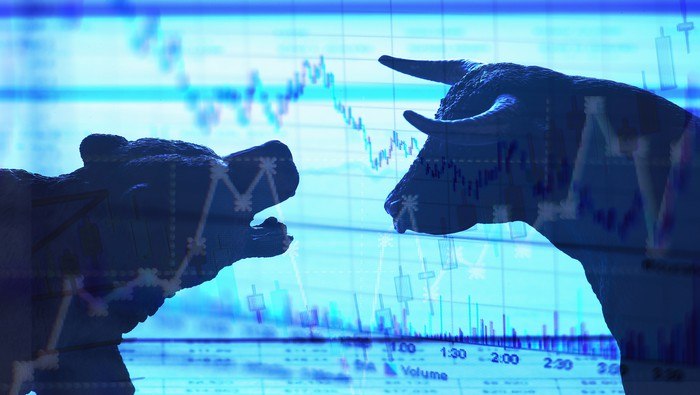Euro Forecast Overview:
- The Euro is no longer the worst performing currency in May, ceding that crown to the British Pound, which remains befallen by hard Brexit fears due to the coronavirus pandemic.
- More significant short-term reversals may gather pace in EUR/JPY and EUR/USD rates through the end of the week, particularly if key technical hurdles are overcome.
- Per the IG Client Sentiment Index, the Euro’s recent gains come against a neutral backdrop.



Euro Gains Come at Safe Havens’ Expense
The Euro has been slowly taking back some of its losses from earlier in the month, ceding the mantle of worst performing major currency in May to the British Pound, which remains plagued by speculation around a hard Brexit. With Europe reopening ahead of the United States, and with speculation building that the Bank of Japan will announce a significant easing program to help an economy already befallen by the Q4’19 sales tax hike, both EUR/USD and EUR/JPY rates have found room to recover in this second full week of May.
ECB May Be Handcuffed, Despite Plans Otherwise
The optimism in the Euro doesn’t seem to jive with the harsh realities emerging on the ground. Despite the ECB signaling its willingness to do more, extraordinary monetary policy on the ECB’s part may be limited. It’s not just that new ECB President Christine Lagarde has been slow on the draw to match the fervor of her predecessor’s “whatever it takes” bazooka-like response, but that the German constitutional court has now demanded that the ECB justify its bond buying program within the next three-months, or else the Bundesbank must withdraw its participation.
This is significant news, insofar as it could set a dangerous precedent moving forward: that national central banks are no longer beholden to the ECB’s bidding, and in turn, that the European Court of Justice – which has previously ruled that the ECB’s QE program was legal – can be bucked by national court systems. The entire episode, particularly during a time of crisis, threatens to do more harm than good.
European Central Bank Interest Rate Expectations (May 12, 2020) (Table 1)
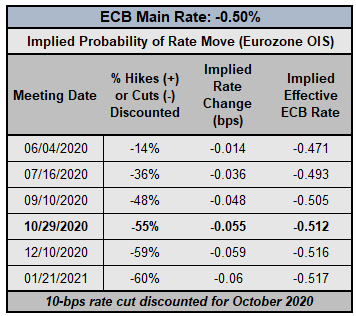
And so, interest rate markets are not expecting the ECB to act again in a meaningful way in the very near future. If the ECB finally decides to embrace more substance rate changes rather than working on the margins, traders are discounting a 55% chance of a 10-bps rate cut materializing in October 2020.
The Reality: ECB Can’t Save the Euro Alone
After a decade of stagnant growth and failure to fully recover from The Great Recession and the Eurozone debt crisis, the European Union is ill-equipped to deal with the task at hand. The coronavirus pandemic demands coordinated efforts across institutions, borders, and boundaries, and in many respects, the EU has failed as its member states have failed one another.
It was only on April 9, after all, that the Eurogroup agreed to a rescue deal that clocks in at €540 billion (paltry compared to what the United States is doing), in part made available through the well-worn European Stability Mechanism (ESM). But the coronavirus pandemic has exposed an old wound: the desire by the less fiscally stable member states to have a federalized European budget. Germany, Austria, and the Netherlands remain opposed to jointly-issued debt among member states, otherwise known as “Eurobonds” – just as the bloc of northern member states did throughout the crisis of the past decade.
And so, the European Union may be nearing a breaking point anew. A lack of a federalized response mechanism, blockaded by the more fiscally stable members of the EU, may be the spark that forces countries to turn inward even faster – and tear the union apart. The ECB failed to inspire a meaningful recovery by the Euro, and now attention shifts back to the Euro more prominently reflecting this fundamental risk vis-à-vis pairs like EUR/JPY and EUR/USD.
EUR/USD RATE TECHNICAL ANALYSIS: DAILY CHART (May 2019 to May 2020) (CHART 1)

Scrapping prior outlooks, the symmetrical triangle consolidation appears to have been much broader than originally examined, now encompassing price action dating back to the middle of March. To this end, the uptrend from the March, April, and May swing lows has been maintained, and the bullish outside engulfing bar forming on the daily chart suggests that a return back towards triangle resistance is possible (which would come in the low 1.0900s over the remainder of the week).
To this end, momentum is slowly turning bullish, as EUR/USD rates are climbing above their daily 5-, 8-, 13-, and 21-EMA envelope, which is not yet out of bearish sequential order. However, both daily MACD (issuing a bullish crossover below its signal line) and Slow Stochastics (turning higher below its median line) suggest that bullish momentum may continue to accelerate in the days ahead.
IG Client Sentiment Index: EUR/USD Rate Forecast (May 12, 2020) (Chart 2)
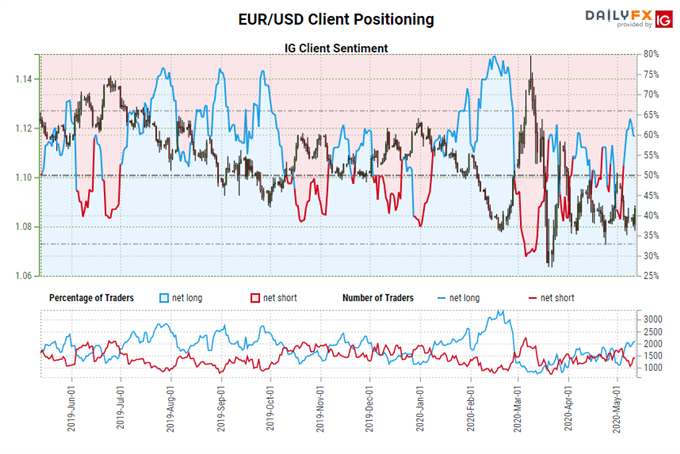
EUR/USD: Retail trader data shows 59.06% of traders are net-long with the ratio of traders long to short at 1.44 to 1. The number of traders net-long is 0.34% lower than yesterday and 33.50% higher from last week, while the number of traders net-short is 15.03% higher than yesterday and 22.76% lower from last week.
We typically take a contrarian view to crowd sentiment, and the fact traders are net-long suggests EUR/USD prices may continue to fall.
Positioning is less net-long than yesterday but more net-long from last week. The combination of current sentiment and recent changes gives us a further mixed EUR/USD trading bias.
EUR/JPY RATE TECHNICAL ANALYSIS: DAILY CHART (May 2019 to May 2020) (CHART 3)
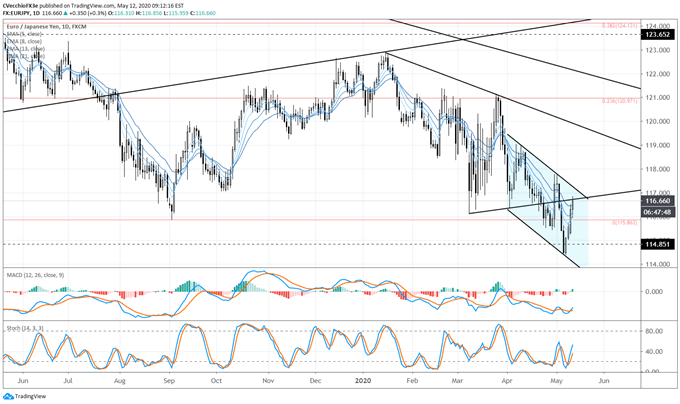
Some context for the recent move in EUR/JPY rates is necessary. At the start of 2020, EUR/JPY’s rally from the September 2019 lows failed at the rising trendline going back to the 2012, 2016, and 2019 swing lows. EUR/JPY rates set new 2020 lowsjust last week (their lowest levels since 2017), finding follow-through on the symmetrical triangle breakout. It still holds that the longer-term context of losses dating back to the 2018 suggests that more downside may be imminent in EUR/JPY rates.
In the near-term, the sharp rally over the past few days has EUR/JPY back at symmetrical triangle support (now resistance) near 116.60, while the descending channel in place since the start of April sees resistance emerging near 117.10 over the coming days. A lackluster performance by risk assets may be enough to grind a halt to the recent move higher. Yet if 117.10 is achieved, a return back into the symmetrical triangle coupled with a break of the descending channel would buttress the argument for a more substantial EUR/JPY turn high.
In terms of indicators, EUR/JPY rates are slicing through the daily 5-, 8-, 13-, and 21-EMA envelope, which is easing out of full bearish sequential order. Daily MACD is trending higher albeit in bearish territory, while Slow Stochastics are returning back above their neutral line. For now, neutrality may be the best stance.
IG Client Sentiment Index: EUR/JPY Rate Forecast (May 12, 2020) (Chart 4)
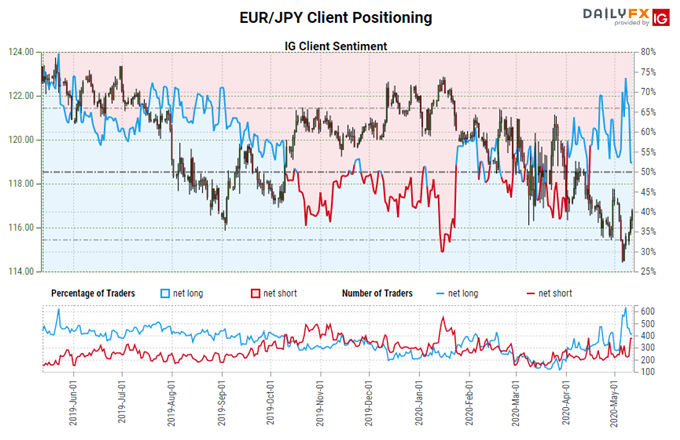
EUR/JPY: Retail trader data shows 49.34% of traders are net-long with the ratio of traders short to long at 1.03 to 1. The number of traders net-long is 24.54% lower than yesterday and 9.93% lower from last week, while the number of traders net-short is 59.17% higher than yesterday and 17.90% higher from last week.
We typically take a contrarian view to crowd sentiment, and the fact traders are net-short suggests EUR/JPY prices may continue to rise.
Traders are further net-short than yesterday and last week, and the combination of current sentiment and recent changes gives us a stronger EUR/JPY-bullish contrarian trading bias.



--- Written by Christopher Vecchio, CFA, Senior Currency Strategist




